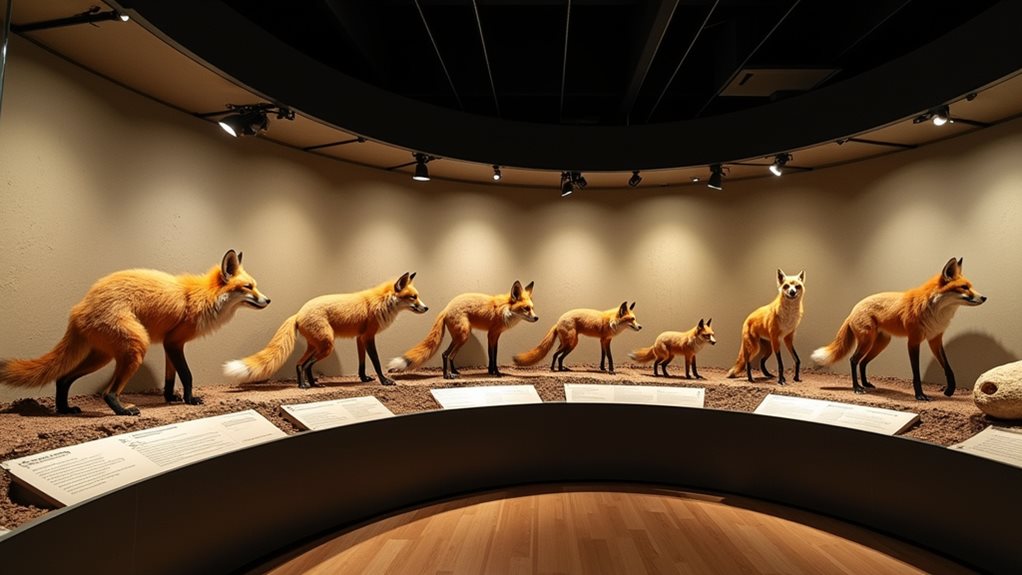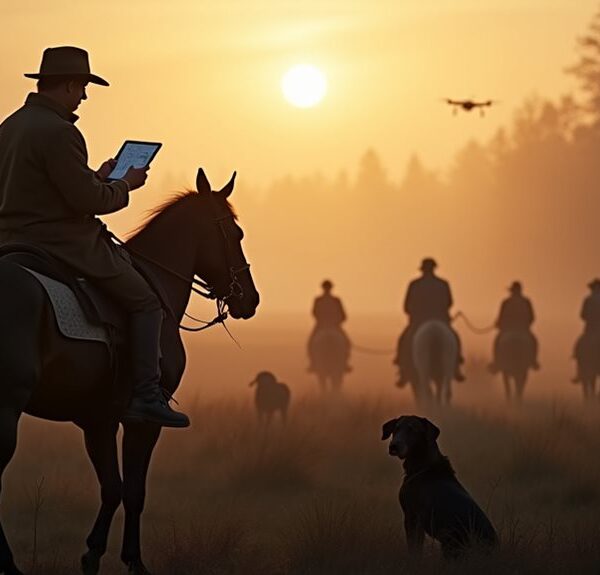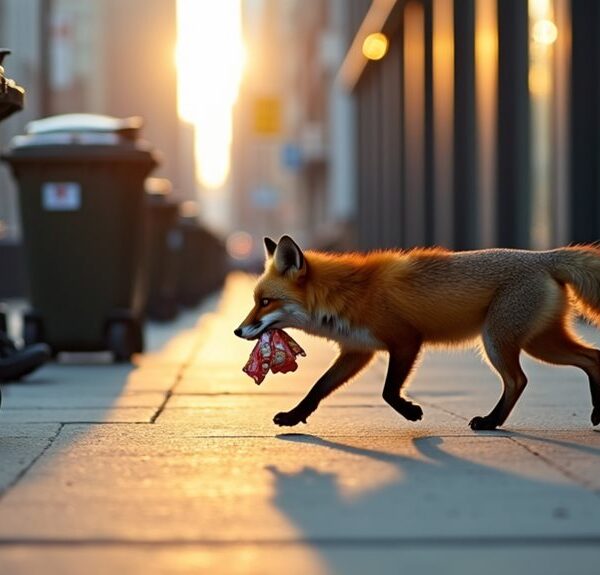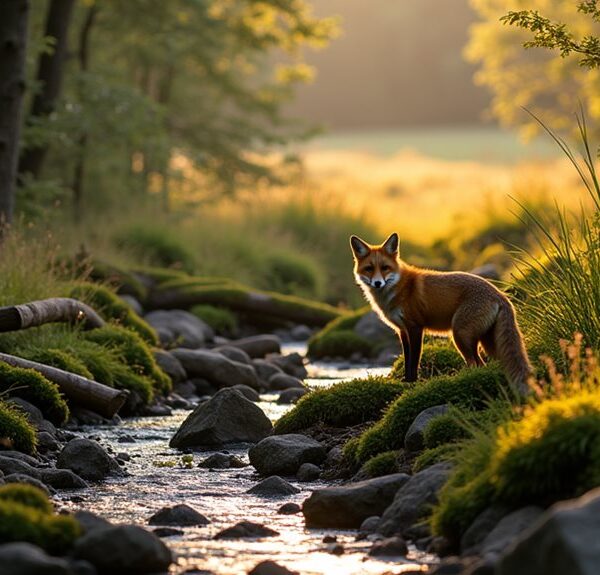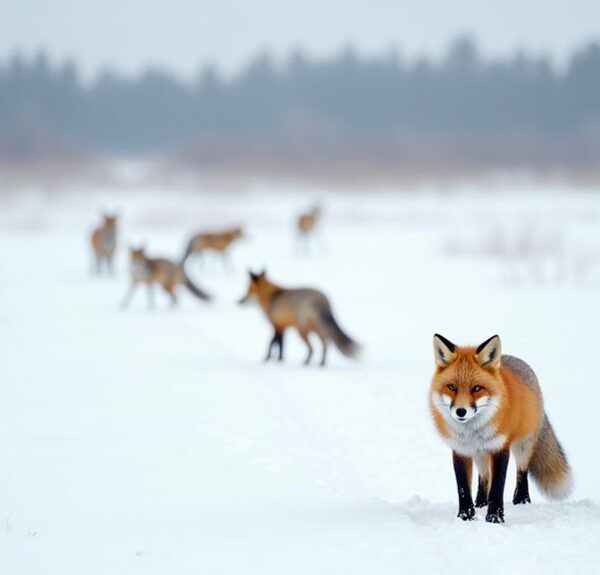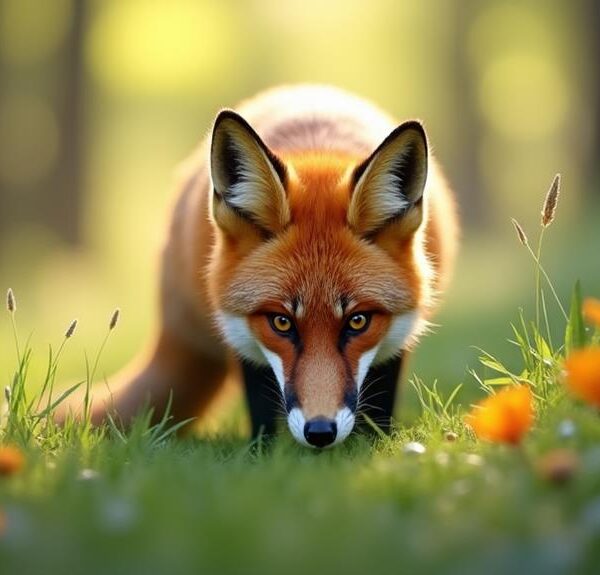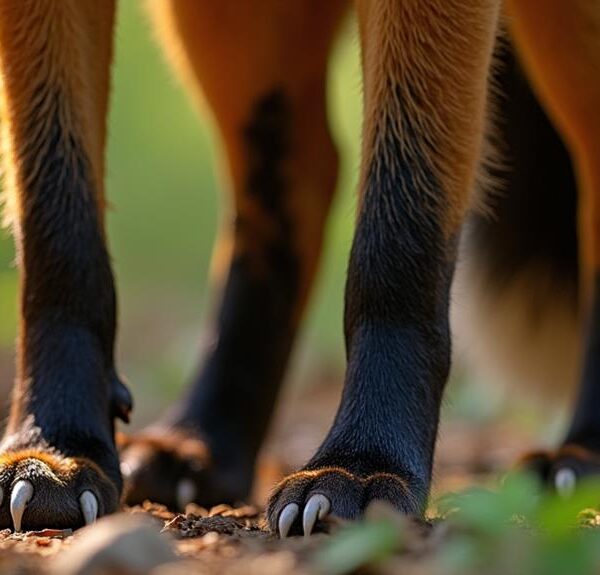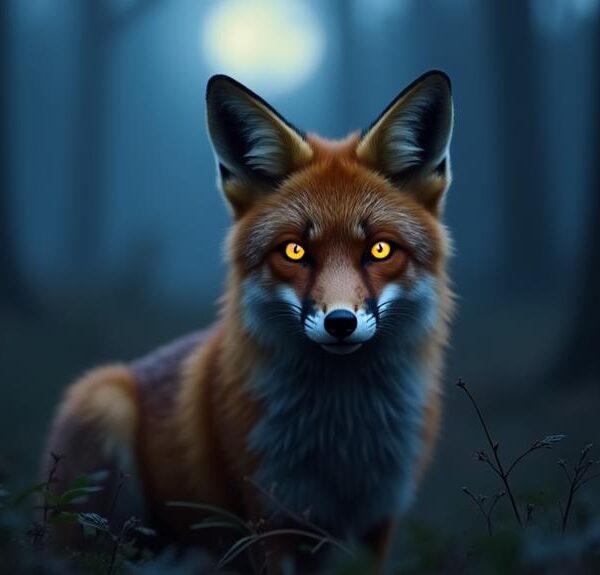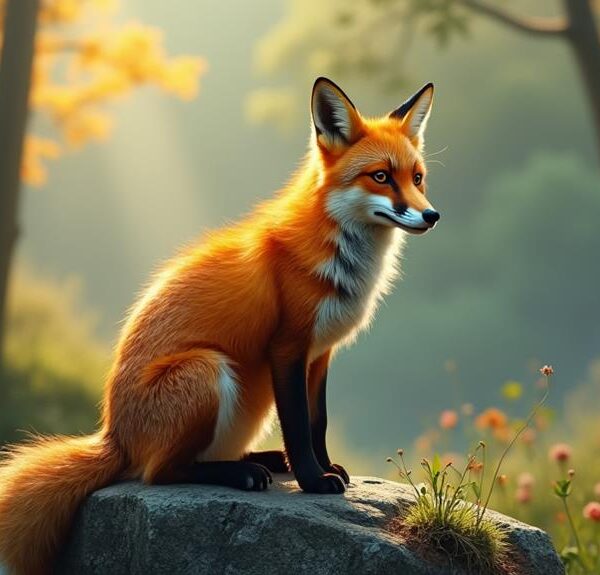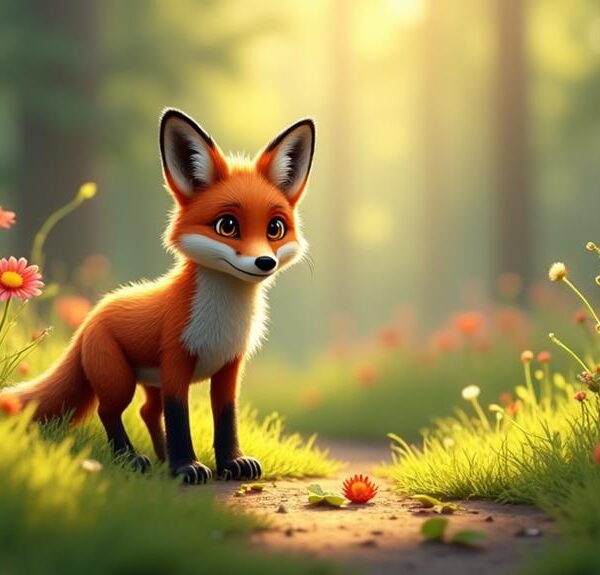Fox evolution over the past 10 million years showcases remarkable adaptability. You’ll see how small Leptocyon ancestors transformed from omnivores into specialized hunters through gradual changes. Their bodies became smaller with longer legs, while teeth evolved from crushing tools to precise cutting instruments. During ice ages, isolated populations developed unique traits—like the Arctic fox’s thick fur or the fennec’s heat-radiating ears. This incredible progression of adaptation explains how foxes conquered nearly every continent on Earth.
Contents
- 1 The Miocene Origins: From Leptocyon to Early Vulpes (10-5 Million Years Ago)
- 2 Climate Shifts and Morphological Adaptations During the Pliocene
- 3 Pleistocene Radiation: How Ice Ages Triggered Fox Diversification
- 4 Dental Evolution: Tracking Dietary Changes Through Fossil Records
- 5 Continental Drift and Geographic Isolation in Fox Speciation
- 6 Behavioral Evolution: Inferring Social Structures From Anatomical Evidence
- 7 Modern Fox Species: Tracing Their Emergence in the Late Quaternary
- 8 Final Thoughts
The Miocene Origins: From Leptocyon to Early Vulpes (10-5 Million Years Ago)
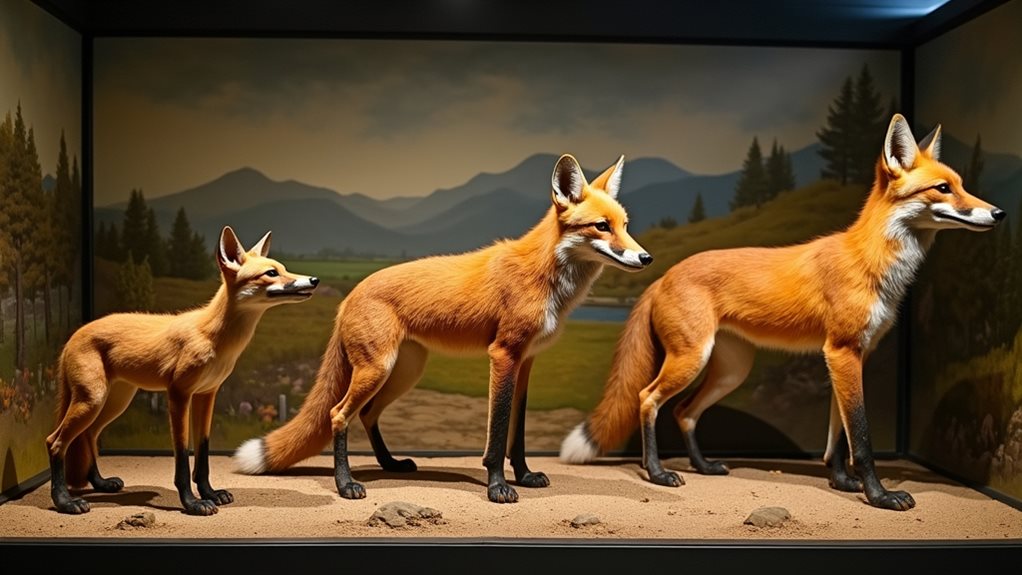
Although our understanding of fox evolution has progressed considerably over time, we haven’t found conclusive fossil evidence supporting the exact pathway from Leptocyon to early Vulpes species during the Miocene epoch. Scientists continue to piece together this evolutionary puzzle through fragmentary remains.
You’ll find it fascinating that Leptocyon characteristics likely included smaller body size and less specialized dentition compared to modern foxes. These ancient canids probably had omnivorous diets, setting the stage for the diverse feeding strategies seen in today’s fox species.
As climate patterns shifted during this period, Vulpes adaptations began to emerge—longer legs, more specialized teeth, and improved sensory abilities that would eventually define the genus. The change wasn’t sudden but occurred gradually as these animals responded to changing environments.
While gaps remain in our knowledge, each new fossil discovery brings us closer to understanding this remarkable evolutionary story.
Climate Shifts and Morphological Adaptations During the Pliocene
You’ll notice dramatic changes in fox anatomy during the Pliocene, as their bodies became smaller to conserve energy in cooling climates. Their teeth transformed from crushing structures to more precise cutting tools, adapting to new prey types that emerged during this era. The most fascinating changes occurred in their skull structure, where you can see how their snouts elongated and eye sockets shifted, giving them the distinctive fox profile we’d recognize today. These adaptations were crucial for survival as foxes encountered new prey types that were reflective of changing environmental conditions.
Shrinking Canid Dimensions
During the Pliocene epoch, a fascinating transformation swept through fox populations as Earth’s climate underwent considerable cooling.
You’ll notice that fox ancestors experienced a notable reduction in body size, with canid size decreasing by nearly 30% compared to their earlier Miocene relatives. These weren’t random changes—they represented direct responses to evolutionary pressures that favored smaller, more energy-efficient predators.
Imagine watching these clever creatures adapt in real time! As forests gave way to expanding grasslands, smaller foxes could better maneuver through dense underbrush while requiring less food to survive the harsher seasons.
Their shrinking dimensions also enabled them to occupy specialized niches that larger predators couldn’t access. This remarkable downsizing wasn’t limited to body mass—skull length, tooth size, and limb proportions all evolved toward the more compact foxes you’d recognize today. Additionally, these adaptations may have contributed to the diverse fox species we see today, emphasizing their ability to thrive in varying habitats around the globe.
Tooth Shape Modifications
Three distinct tooth shape modifications marked the Pliocene epoch‘s impact on fox evolution, demonstrating nature’s remarkable adaptability to changing conditions.
You’ll notice that as climate patterns shifted, fox tooth morphology transformed in fascinating ways. Their canines became sharper and more elongated, perfect for catching small, quick prey that thrived in new grassland environments.
The most striking change was in their molars, which developed specialized ridges for better grinding vegetation—a clever backup plan when meat was scarce! This dietary specialization allowed foxes to survive seasonal fluctuations that would have starved their ancestors.
You can actually trace these changes in fossils from different soil layers, like reading nature’s recipe for survival. Interestingly, adaptations like physical adaptations in insulation and shape also played a crucial role in their survival during colder periods. Isn’t it amazing how these small tooth adjustments helped shape the foxes you might spot in your backyard today?
Skull Structure Changes
While the Pliocene’s cooling climate dramatically reshaped tooth structures, its impact on fox skull morphology proved even more profound.
You’ll notice that during this critical period, fox skulls transformed from broader, more robust shapes to the streamlined profiles we recognize today. These changes weren’t random—they resulted from intense evolutionary pressures as foxes adapted to hunting smaller, faster prey in expanding grasslands.
The most fascinating change? Their eye sockets shifted slightly forward, improving depth perception for precise pouncing. You might be surprised to learn that modern foxes can judge distances six times more accurately than their ancient ancestors could!
Their brain cases also expanded by nearly 15%, particularly in regions controlling spatial awareness and hunting strategies. When you look at a fox today, you’re seeing the brilliant result of millions of years of skull refinement. Additionally, their adaptability during this time paralleled the development of seasonal fur color change, enhancing their hunting efficacy in varying environments.
Pleistocene Radiation: How Ice Ages Triggered Fox Diversification
You’ll be amazed at how fox species exploded in diversity during the ice ages, establishing populations in isolated glacial refuges where they developed unique adaptations. As temperatures fluctuated dramatically, these clever canids underwent rapid changes in fur density, body size, and metabolic efficiency—traits that helped them thrive in harsh conditions. Their remarkable adaptive radiation during this period explains why you can now find specialized fox species across vastly different environments, from the Arctic’s frozen tundra to the scorching desert terrains. This period also contributed to the evolution of species like the Sierra Nevada red fox, which today faces critical endangerment due to habitat loss.
Glacial Refuge Adaptation
As glaciers advanced and retreated across continents during the Pleistocene epoch, fox species faced extraordinary evolutionary pressure that would forever reshape their lineage.
You’ll find that foxes didn’t just survive these harsh conditions—they thrived through remarkable adaptation strategies.
During this period, habitat fragmentation created isolated populations, each developing unique traits to match their specific refuges. The Arctic fox, for instance, evolved smaller ears and limbs to reduce heat loss, while its desert cousins developed larger ears to disperse heat. This adaptation included a thick, double-layered coat that provides insulation against extreme cold.
This climate resilience wasn’t merely about enduring the cold; it was about mastering it.
What’s fascinating is how quickly these adaptations emerged—sometimes within just a few thousand years, an evolutionary blink of an eye!
These isolated populations eventually became the diverse fox species you recognize today.
Adaptive Trait Explosion
The Pleistocene epoch marked a dramatic turning point in fox evolution, triggering what scientists now call an “adaptive trait explosion.”
During this period, the planet’s fluctuating ice ages didn’t just challenge fox survival—they catalyzed an unprecedented diversification of species that would reshape the entire Canidae family.
You’d be amazed by how these clever creatures responded to environmental pressures! As ice sheets advanced and retreated, foxes developed remarkable adaptive behaviors.
Their ears grew larger in warmer regions for heat regulation, while northern populations evolved smaller ears to conserve warmth. Their fur thickness, paw size, and even metabolic rates shifted dramatically across different regions.
This wasn’t just change—it was innovation on fast-forward.
Think of it as nature’s laboratory, experimenting with fox designs to fit every possible niche the ice ages created. Notably, the physical adaptations observed in Arctic foxes today, such as their thick fur and compact body structure, are results of these historical environmental pressures during the Pleistocene.
Dental Evolution: Tracking Dietary Changes Through Fossil Records
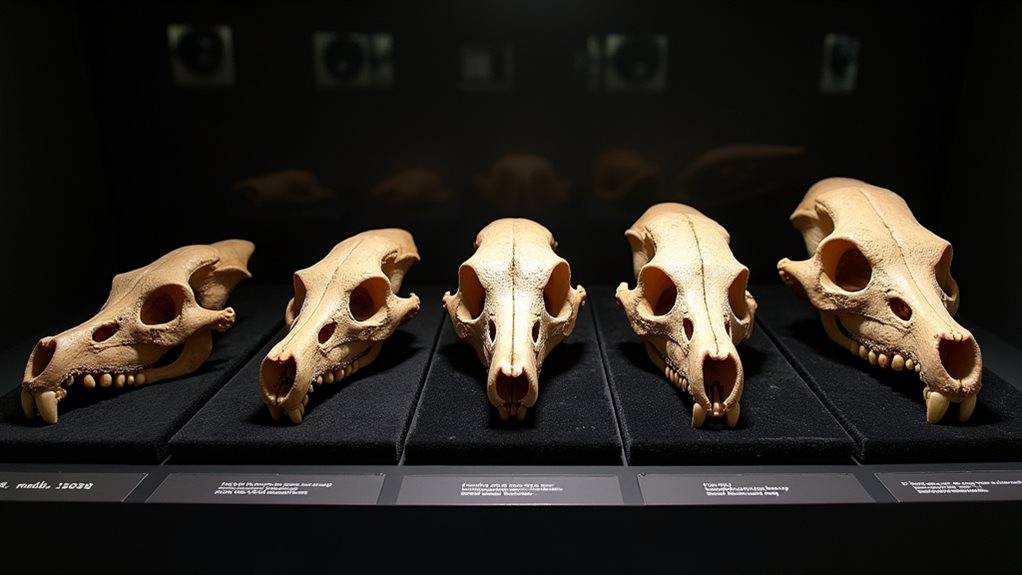
Fossil records of fox teeth provide fascinating insights into how their diet evolved over millions of years. When you examine the dental morphology of ancient fox species, you’ll notice dramatic changes that reflect their adaptation to different food sources. Early foxes had less specialized teeth, but as environments shifted, their dental structures transformed accordingly.
Fossil analysis reveals that about 5 million years ago, many fox species developed sharper carnassial teeth, allowing them to process meat more efficiently. You’ll find it remarkable how these changes coincided with climate cooling events that altered prey availability.
Isn’t it amazing how nature’s blueprint adapts so precisely? The teeth tell a story of survival – from omnivorous beginnings to more specialized hunting patterns, documenting not only what foxes ate, but how they competed and thrived through evolutionary time.
Continental Drift and Geographic Isolation in Fox Speciation
When continental landmasses began their slow drift apart millions of years ago, they created the perfect conditions for fox evolution to take fascinating new directions.
You’ll find it amazing how these geological changes forced fox populations to adapt to completely new environments!
As continents separated, fox populations experienced genetic drift, creating distinct species that couldn’t breed with their distant cousins.
You can see this incredible diversity today in the Arctic fox‘s thick white coat versus the desert fox‘s large ears and sandy coloration.
Each isolated population found unique ecological niches to fill.
As landmasses drifted apart, fox populations discovered their own special places in nature’s grand puzzle.
The kit fox developed specialized hunting techniques for desert environments, while the fennec fox evolved those adorable oversized ears to dissipate heat. Additionally, the adaptive traits seen in fox species, like their claws and fur, reflect their specific environmental challenges.
Nature’s laboratory of isolation has given us the diverse fox family you know today!
Behavioral Evolution: Inferring Social Structures From Anatomical Evidence
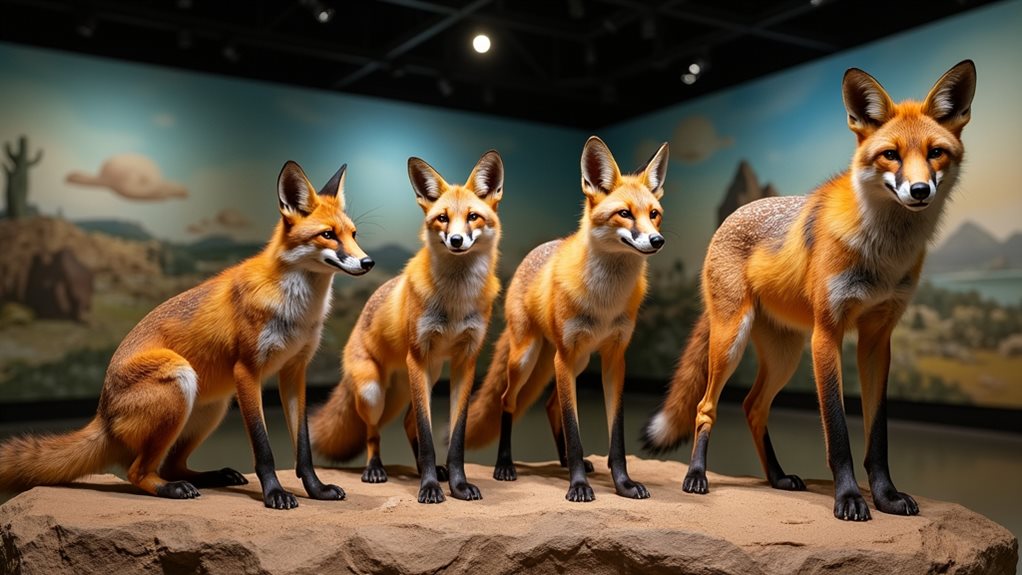
While observing fossilized fox skulls, paleontologists can make fascinating inferences about ancient social structures that once governed fox communities. When you examine the cranial capacity and jaw development across different time periods, you’ll notice patterns suggesting evolving social hierarchies.
These early foxes likely developed complex communication systems that helped them establish group dynamics. Evidence of cooperative breeding appears in the fossil record too. You can see it in the anatomical changes of females from certain periods, whose skeletal structures suggest they shared kit-raising responsibilities.
Interestingly, competition among foxes for resources and mating opportunities influenced these social structures, reflecting the dynamic nature of their evolving hierarchies.
Isn’t it amazing how tiny bone variations tell such rich stories? Some fox species developed more pronounced pack tendencies while others evolved toward solitary behaviors. These shifts weren’t random but responses to changing environments and food sources.
Modern Fox Species: Tracing Their Emergence in the Late Quaternary
Although the earliest recognizable fox species emerged millions of years ago, the modern foxes you’d recognize today primarily evolved during the Late Quaternary period, roughly 100,000 years ago.
During this time, dramatic climate shifts created diverse fox habitats, from arctic tundra to desert terrains.
You might wonder how foxes adapted so successfully! The answer lies in evolutionary pressures that shaped their remarkable versatility. As ice ages came and went, foxes developed specialized traits—like the Arctic fox’s insulating fur or the fennec fox’s heat-radiating ears. Their famous intelligence also evolved as a survival strategy.
In the face of climate change challenges, these adaptations have been critical for their survival. When you spot a fox in your neighborhood, you’re witnessing the result of an incredible evolutionary expedition. These adaptable creatures have conquered nearly every continent, proving that flexibility is nature’s ultimate survival skill!
Final Thoughts
You’ve witnessed the remarkable expedition of our furry friends across 10 million years—from tiny Leptocyon to today’s diverse fox family. Through nature’s challenges and Earth’s dramatic makeovers, foxes have crossed the rainbow bridge of evolution with remarkable resilience. Their changing teeth, social patterns, and adaptations to harsh climates tell a story that’s not merely about survival, but about thriving against the odds. Fox evolution isn’t merely history—it’s inspiration.

